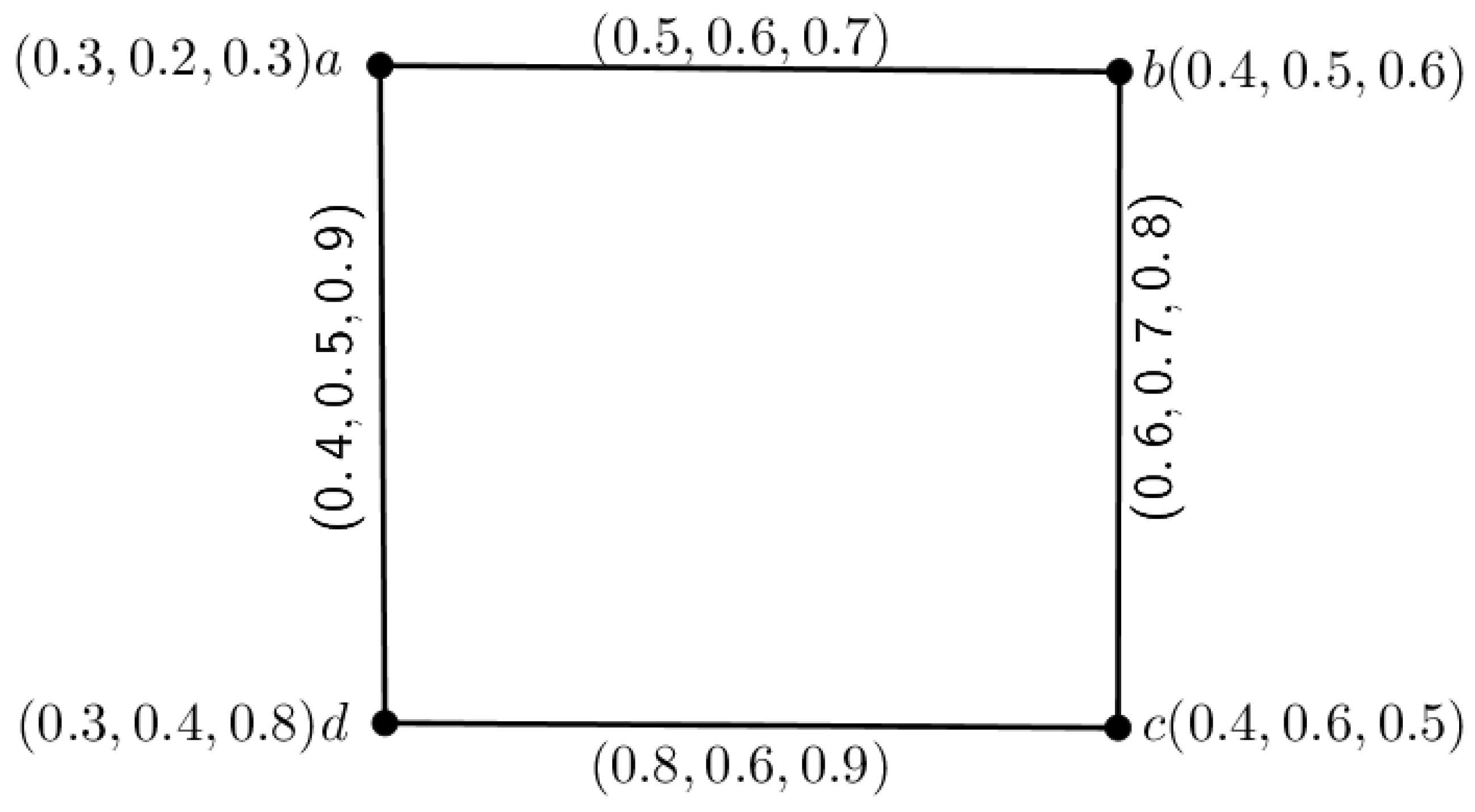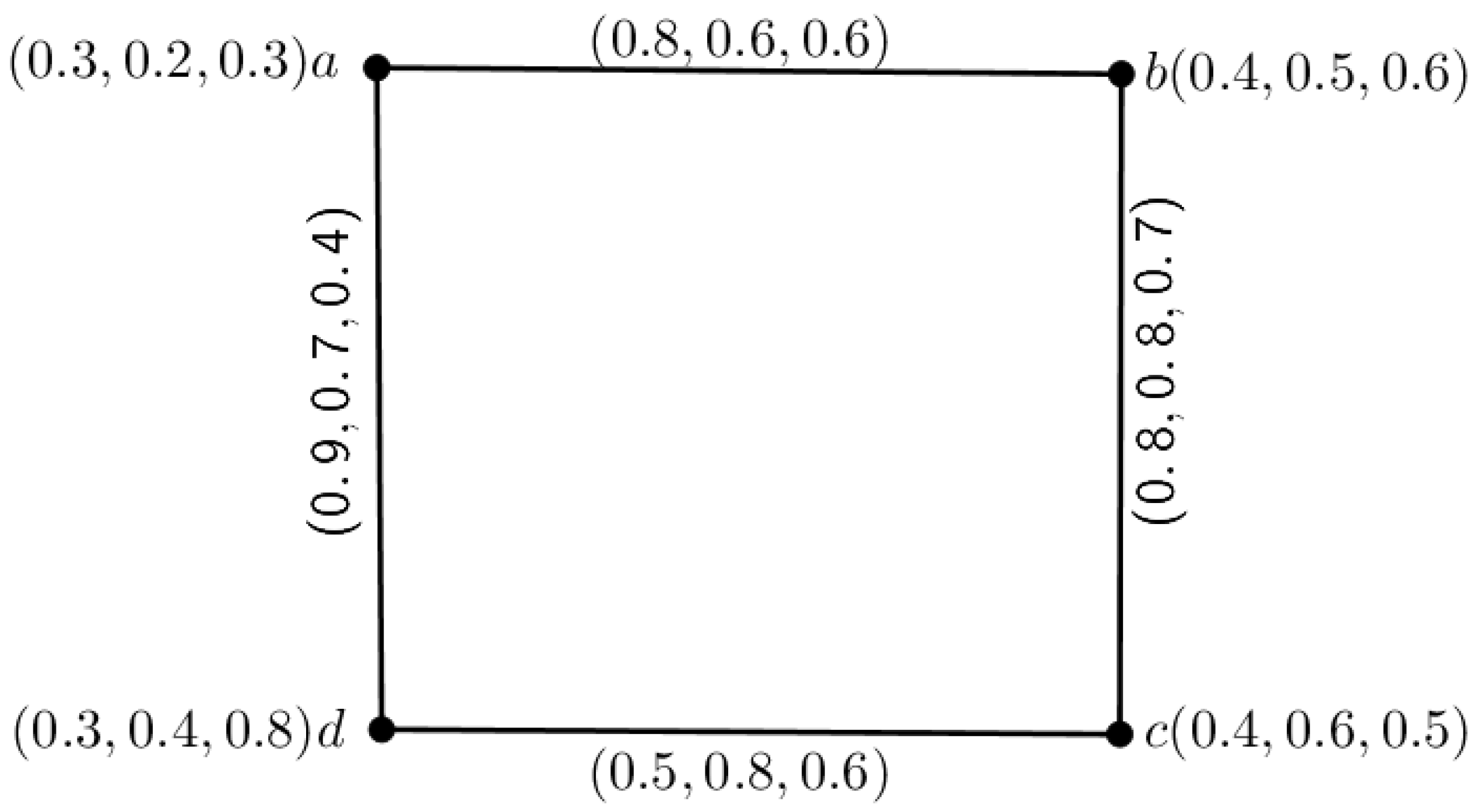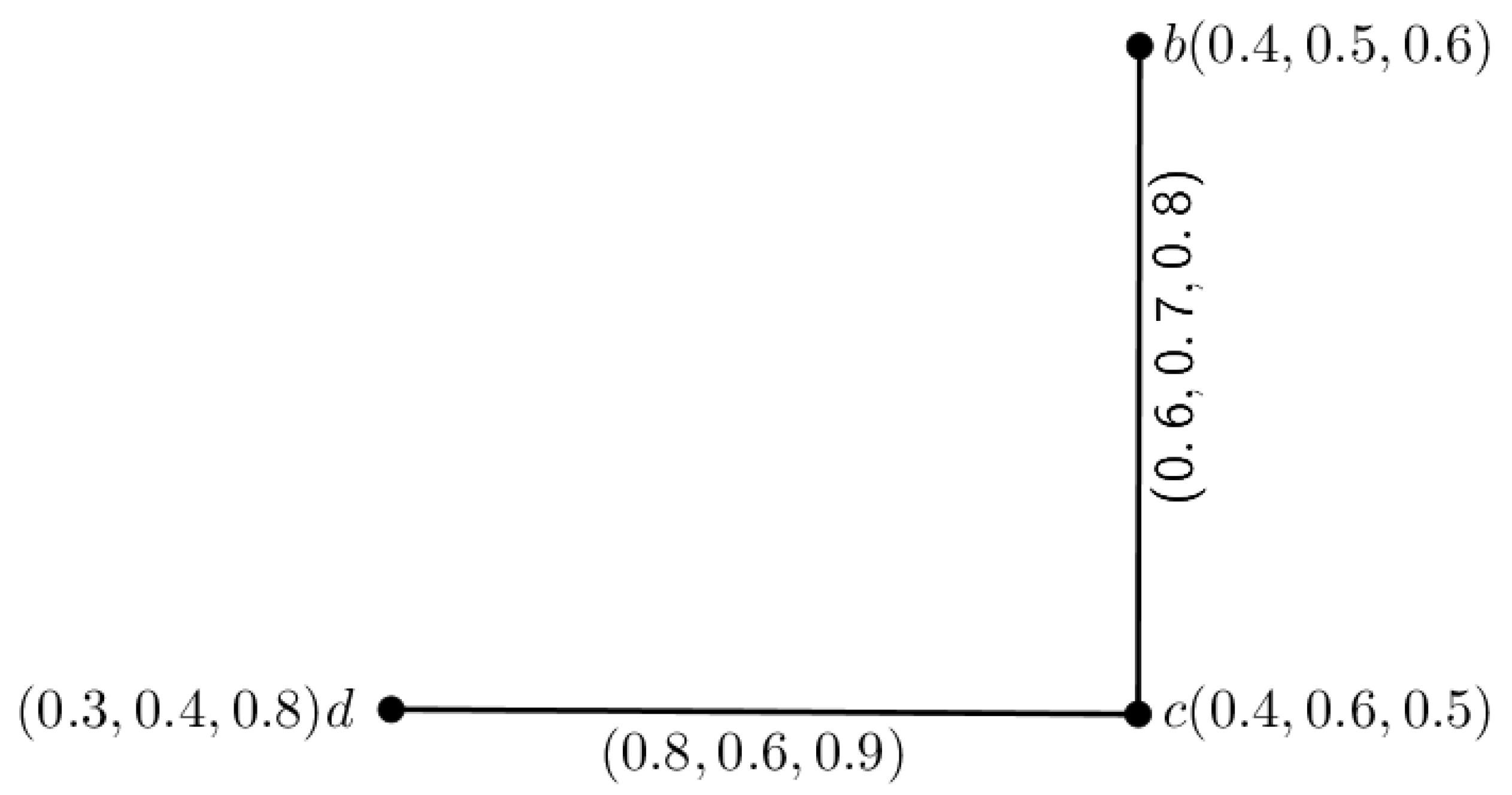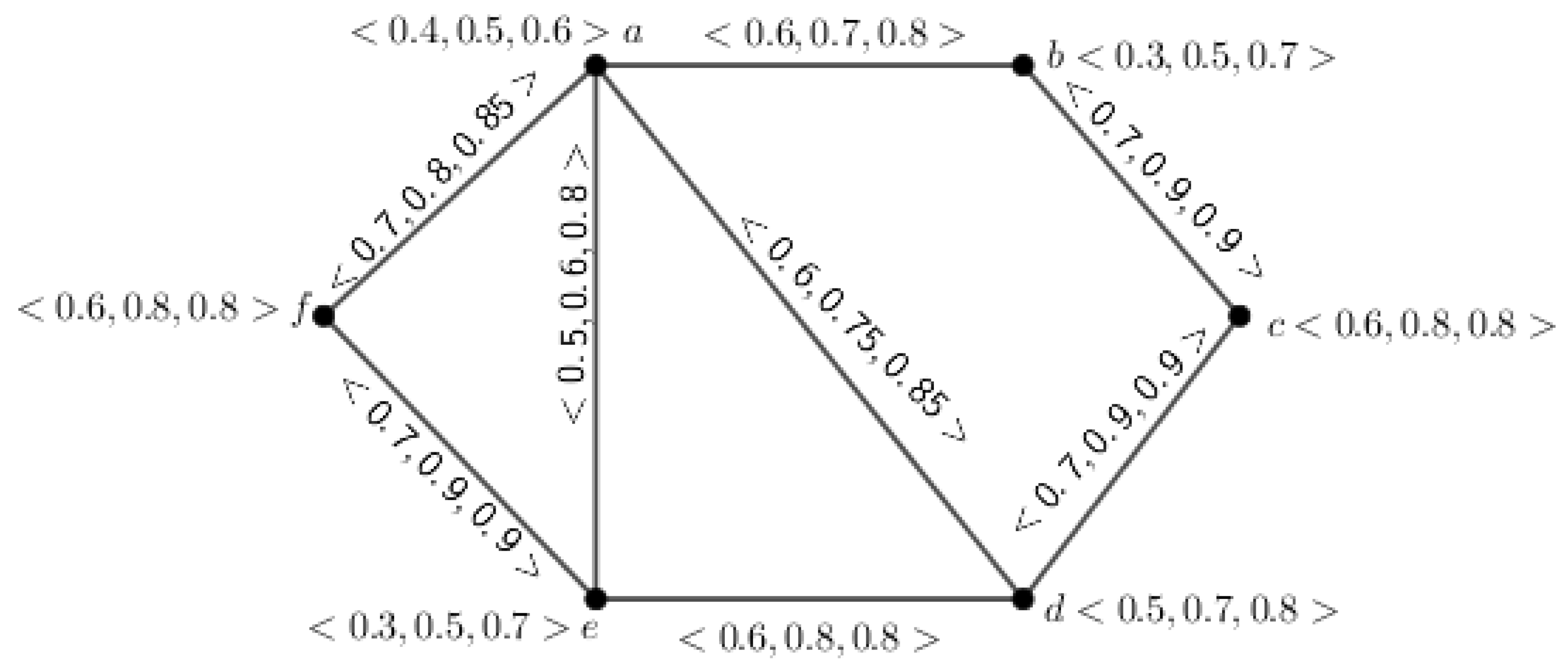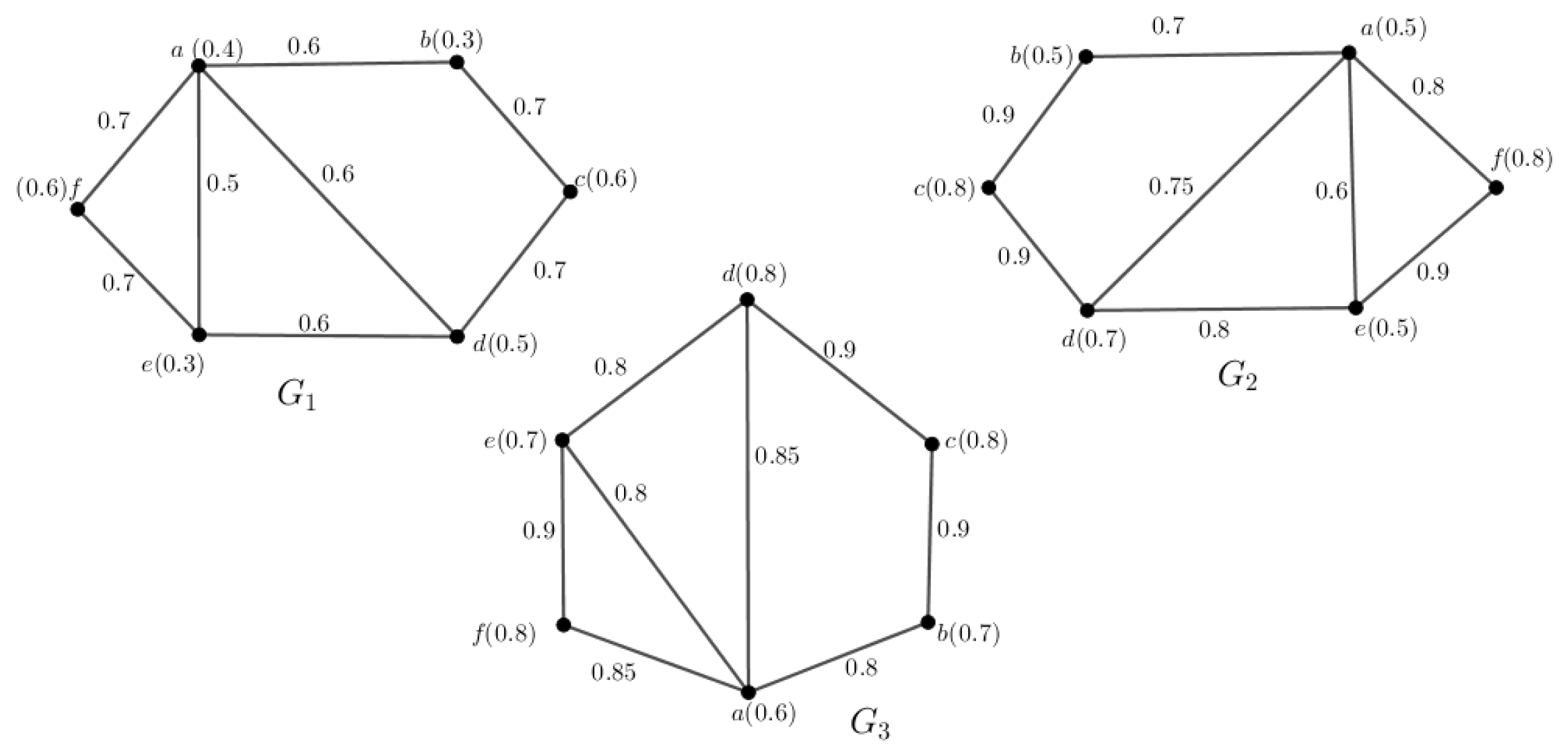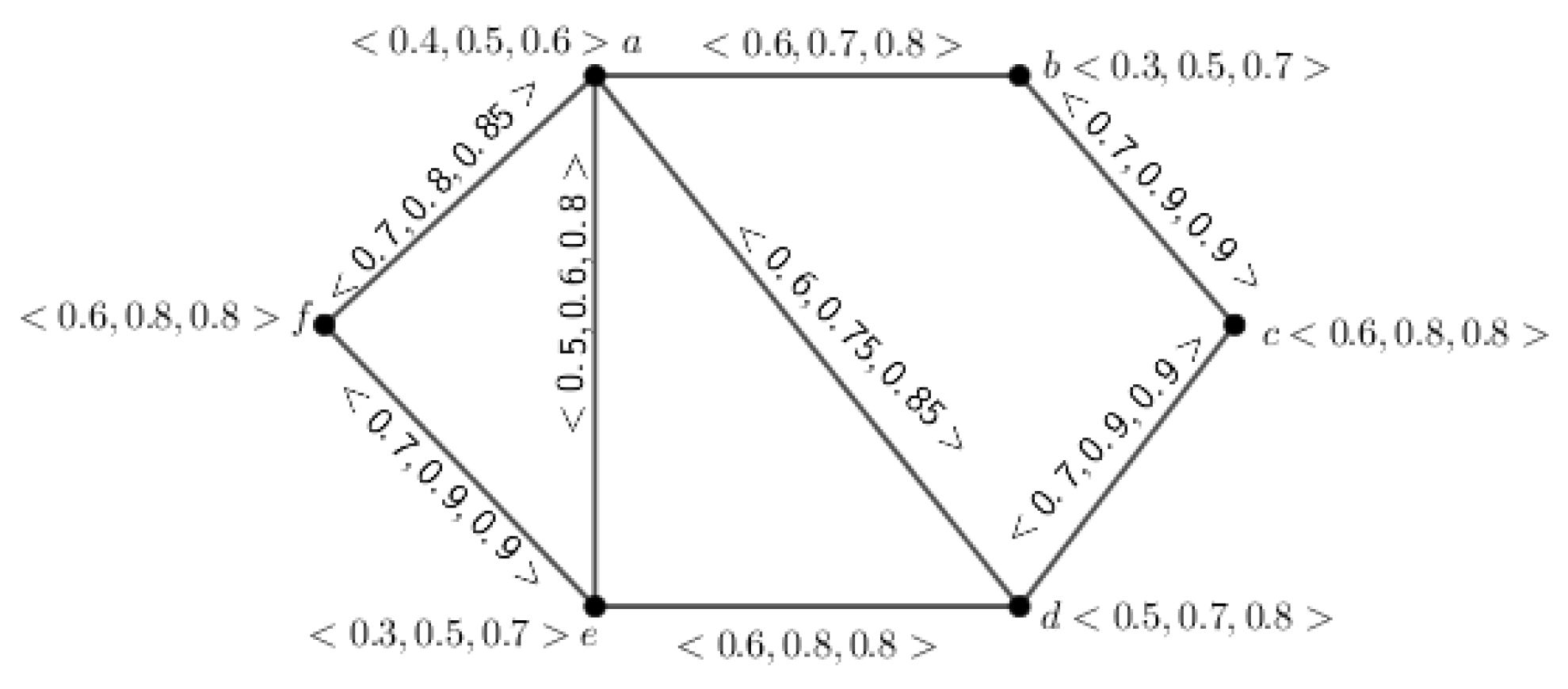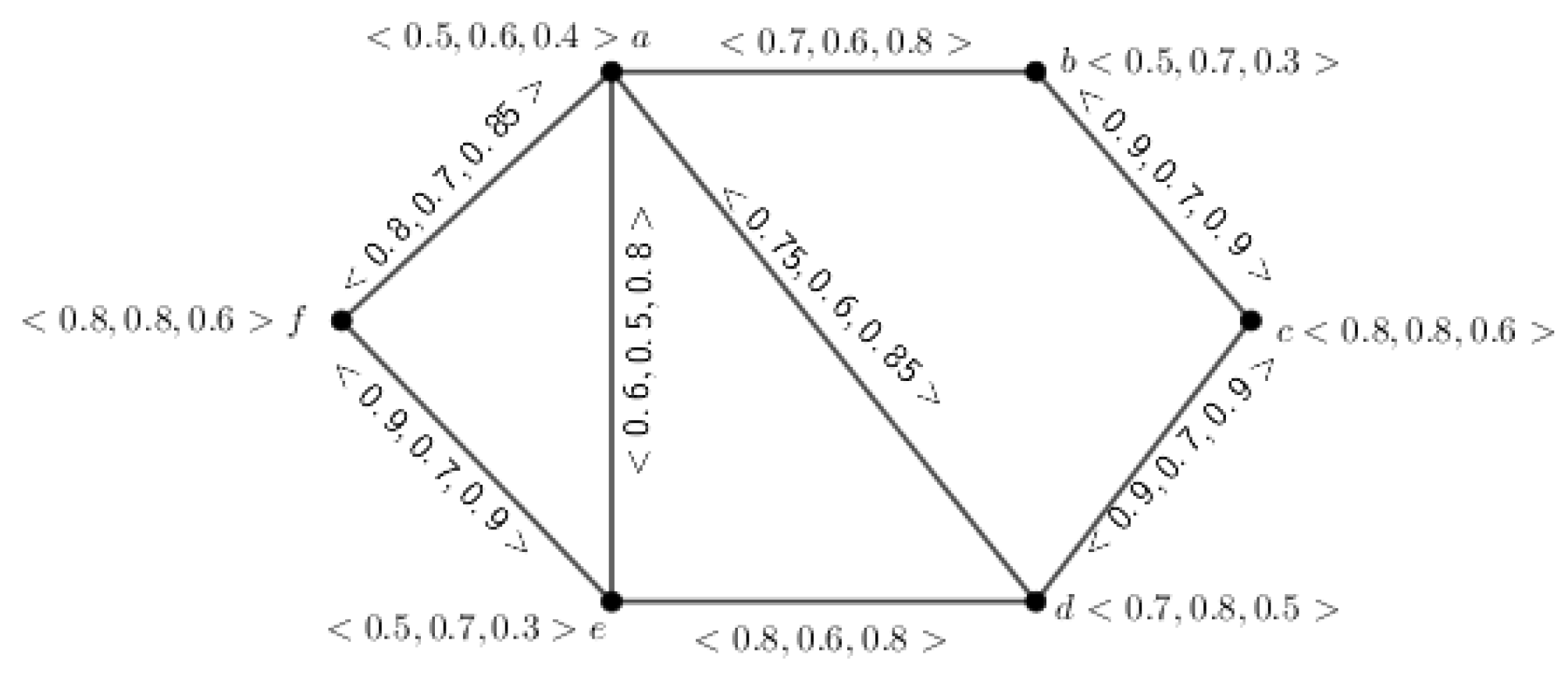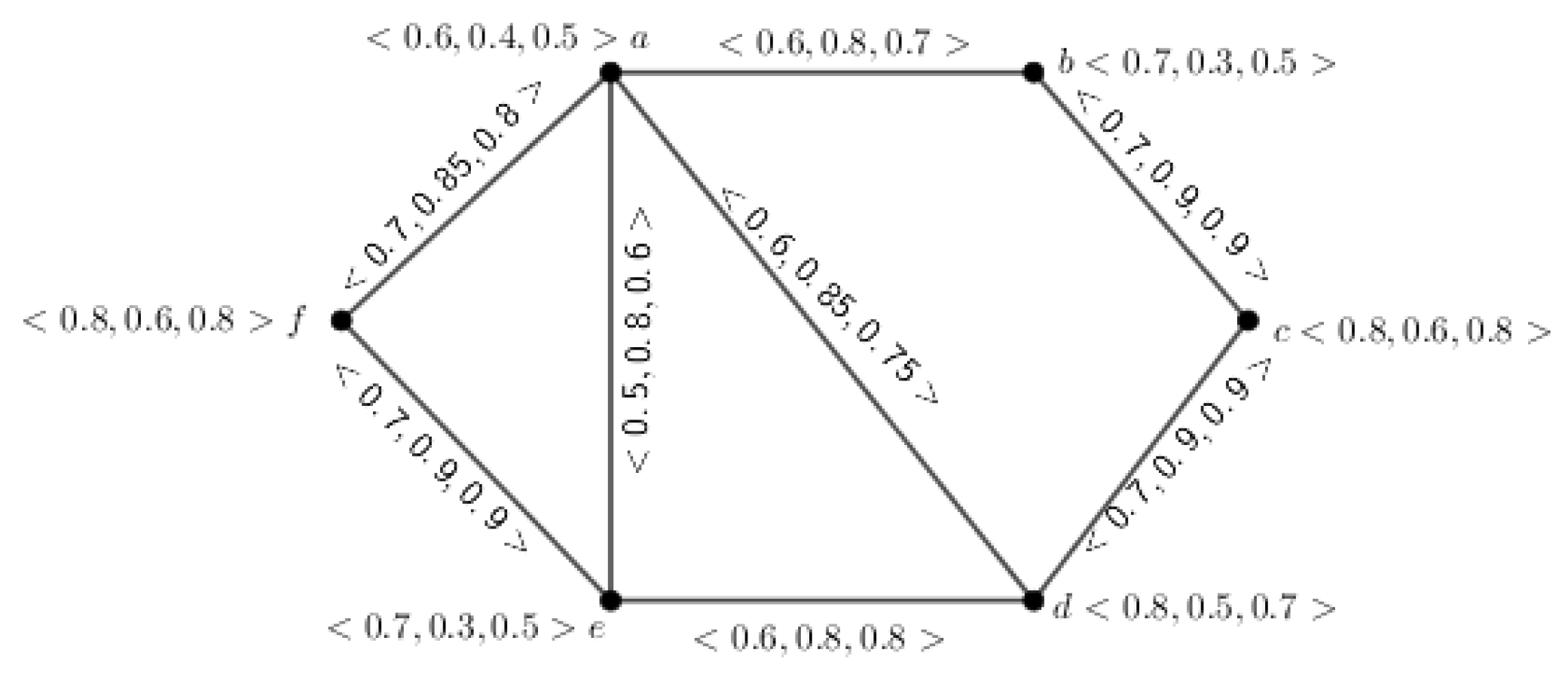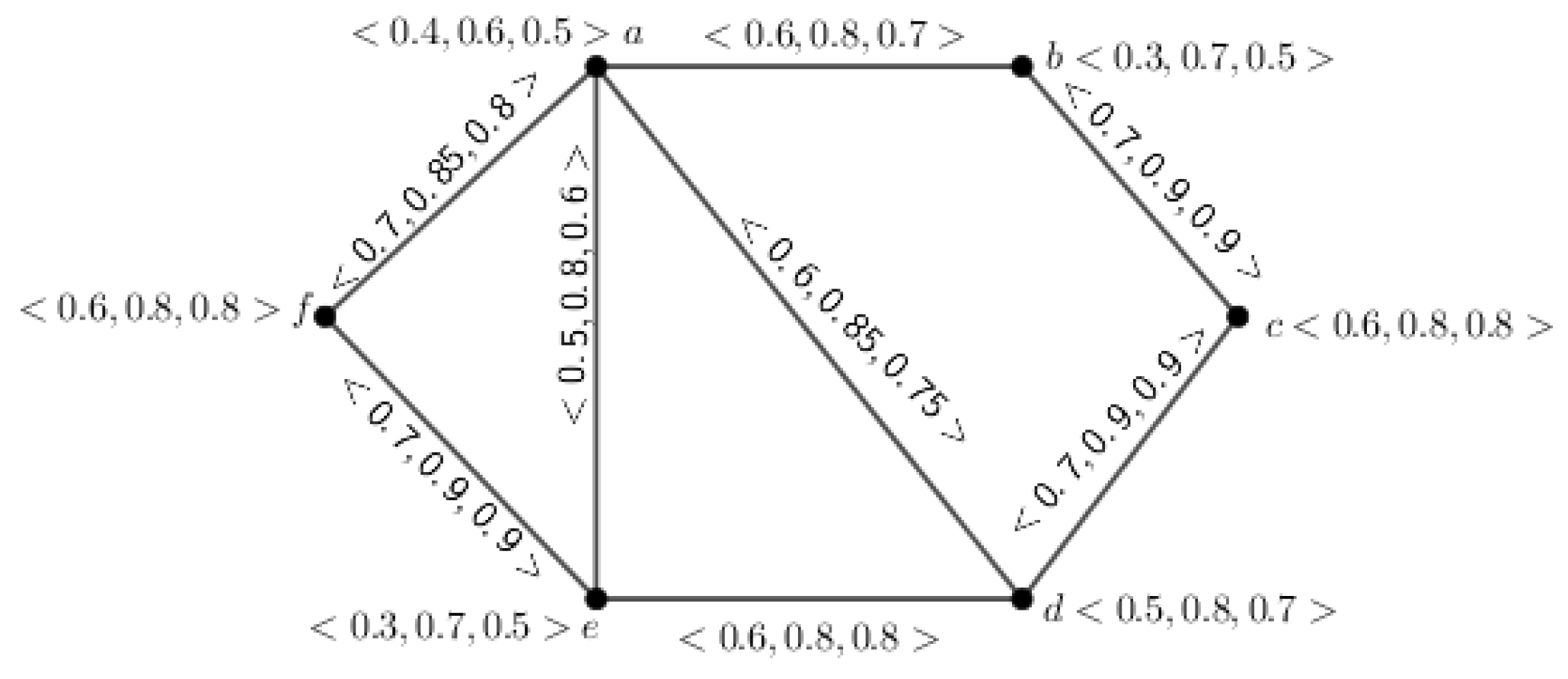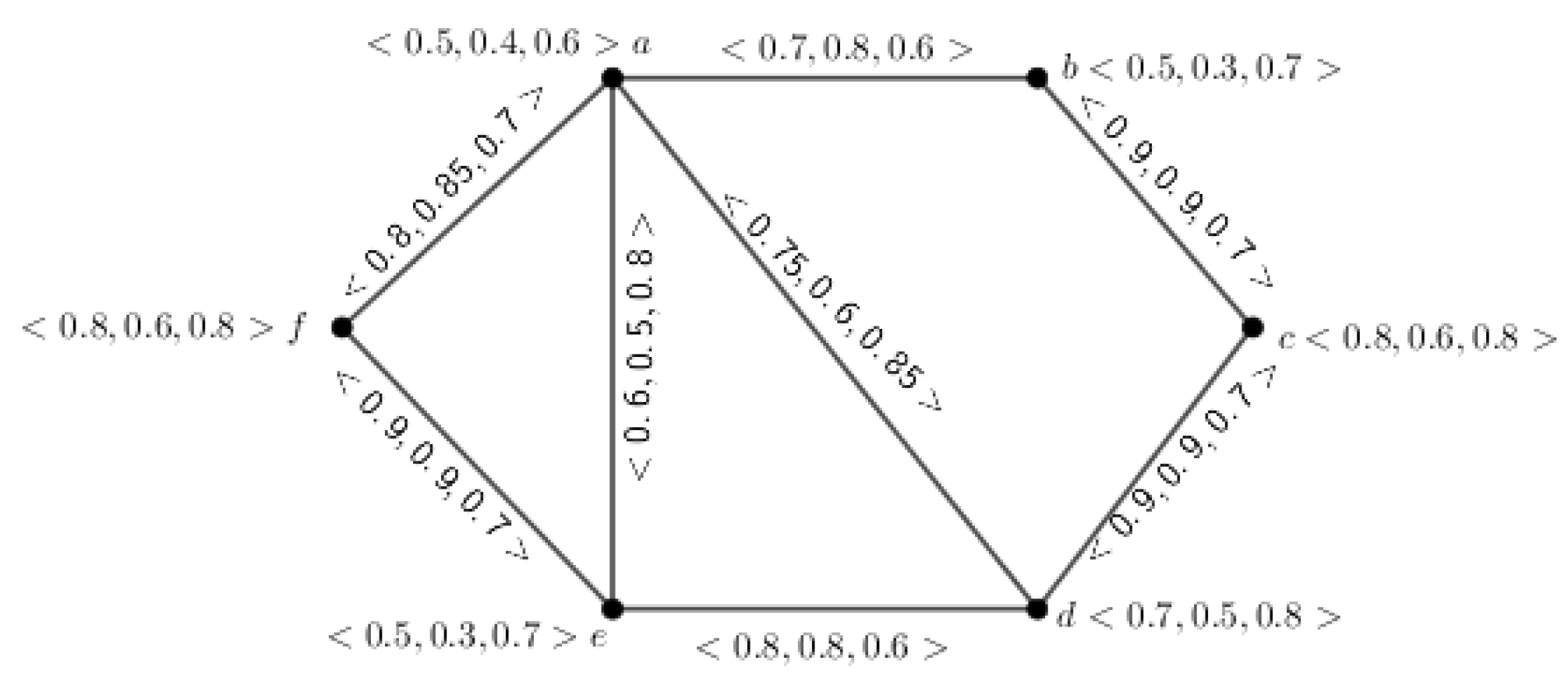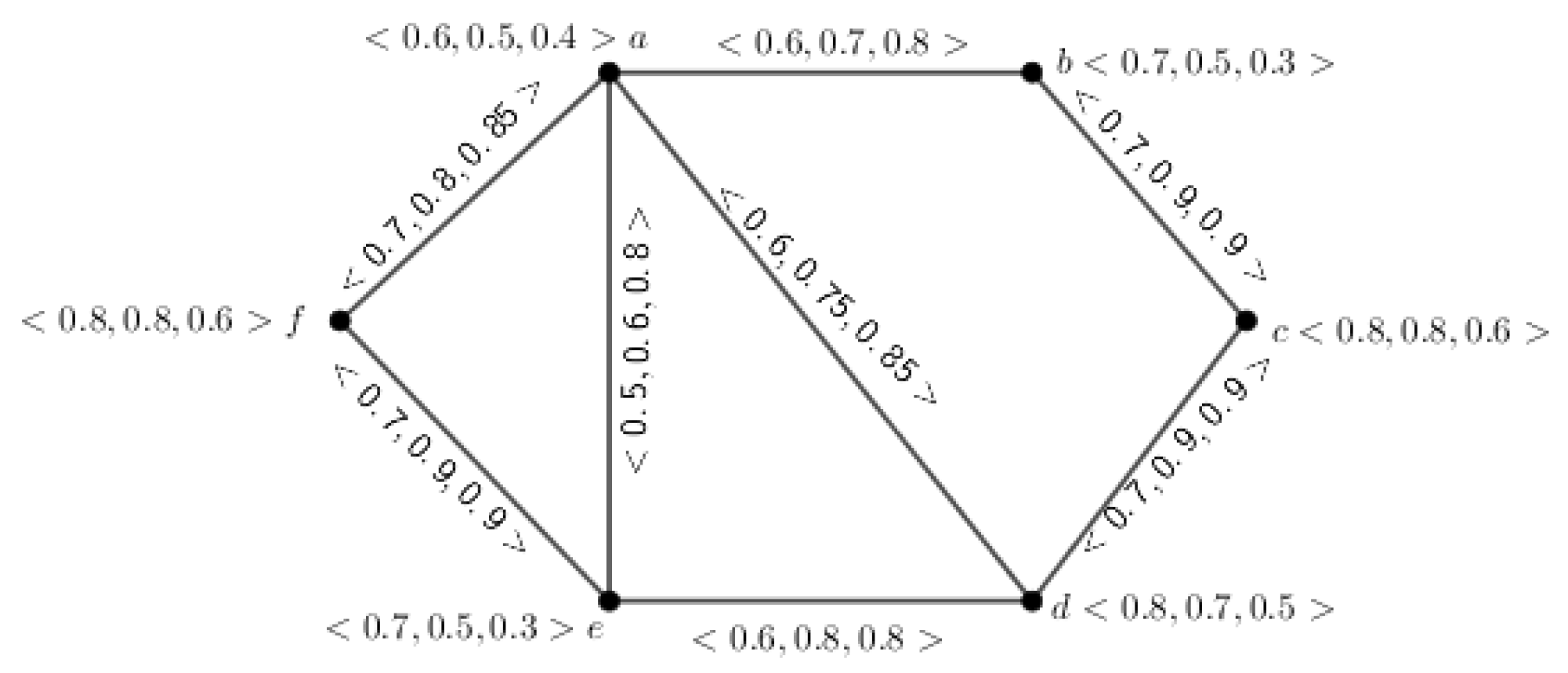2. Preliminaries
Here, we shortly revisit a few definitions related to mPFG, like strong mPFG, complete mPFG, and path in mPFG.
Throughout this article, indicates the sth material of projection mapping, and is denoted by .
Definition 1 ([14]). Take to be an mPFG of the UCG , where σ and μ map from to and to , respectively. Here, σ and μ represent an mPFS of and , respectively, which maintain the relation for every and as well as 0 for every .
Definition 2 ([15]). is assigned as a complete mPFG if for every and .
Definition 3 ([14]). is assigned as an mPF strong graph iffor every and . Definition 4 ([20]). Let be an mPFG and be a path in G. denotes the strength of P, which is defined as , .
The strength of the connectedness of a path in-between and is denoted by and is given as follows:where . Definition 5 ([16]). For an mPFG, an edge is considered independently strong in if . If not, it is perceived as weak on its own. The sth component of the strength of an edge is defined as Definition 6. Take and as two mPFGs of the UCG and , respectively. An isomorphism is a bijection of G and , that is, , and satisfies and every . G is then said to be isomorphic with . 3. Inverse -Polar Fuzzy Graph
In this section, we discuss a new idea of mPFGs, which have nodes and edges along with an MV such that they fulfill a specific criterion.
Definition 7. Let be an mPFG of the UCG , where σ and μ map from to and to , respectively. Here, σ and μ represent an mPFS of and , respectively, which maintain the relation for every and as well as for every .
Example 1. The above definition is depicted through an example, which is given in Figure 1. Definition 8. Let be an inverse mPFG, having UCG . Then, G is called a complete inverse mPFG if and , .
Example 2. The above definition is illustrated through an example, which is given in Figure 2. Definition 9. Let be an inverse mPFG. Then, the complement of G is indicated by , which is conferred by and , for .
Note 1: It is clear from the above discussion that the union of inverse mPFG and complement inverse mPFG does not form a complete inverse mPFG.
Definition 10. Suppose and are the inverse mPFGs of the UCG and , respectively. An isomorphism is a bijection between G and , that is, , and satisfies and for every . Then, G is said to be isomorphic to . Definition 11. Let and be two inverse mPFGs. Then, is called a partial inverse mPFG of G if and , for all as well as , for all .
Definition 12. Let and be two inverse mPFGs. Then, is called an inverse mPF subgraph of G if and , for all as well as , for all .
Definition 13. Let be an inverse mPFG. Let . Then, the order of x is indicated by and conferred by , for . The total degree of the vertex x is indicated by and is conferred by for . The degree of G is indicated by and is conferred by , for . The size of G is indicated by and conferred by , for .
Definition 14. Let be an inverse mPFG. Then, α-cut, , is indicated as and is defined by and .
In ordinary mPFG theory, we know that every -cut, , is a crisp graph. But, in our proposed model, this is not generally true; it is possible that not every -cut, , of an inverse mPFG is a crisp graph. This is illustrated through Example 4.
Example 4. Let us consider . Then, the α-cut of the mPFG of Figure 1 is shown in Figure 4. Theorem 1. Let be an inverse mPFG of an UCG and . If for any , and , for every and for each , then is a crisp graph.
Proof. Suppose for each . Then, we must have and , for each , or and , for each . It is clear for case 1.
For the second case, if and , for , then we obtain , for , which is a contradiction.
Hence, is a crisp graph. □
Theorem 2. Let be an inverse mPFG of an UCG. If there exists a and an edge such that , for , then is not a crisp graph.
Proof. If possible, let be a crisp graph. Then, we must have as an mPFG. Then, from the definition of mPFG, we have , . Again, from the definition of an inverse mPFG, we obtain , .
Combining both of them, we obtain, , , which is a contradiction, hence the theorem. □
3.1. Decomposition and Composition of Inverse m-Polar Fuzzy Graph
3.1.1. Decomposition
By collecting each component from the inverse m-polar fuzzy graph, we can construct the m number of fuzzy graphs. An inverse m-polar fuzzy graph, G, is used for this purpose. The inverse m-polar fuzzy graph G can be created by building the graph and edges using the ith component of the membership values of the nodes in the fuzzy graph . The following example is used to demonstrate this concept.
Example 5. The above definition is depicted through an example, which is given in Figure 5. Here, we consider the inverse 3PFG shown in Figure 6. Taking the first component for each node and edge of G, we obtain an inverse fuzzy graph . Taking the second component for each node and edge of G, we obtain an inverse fuzzy graph . Finally, taking the third component for each node and edge of G, we obtain an inverse fuzzy graph . Hence, we obtain three inverse fuzzy graphs from G. All those inverse fuzzy graphs are shown in Figure 6. 3.1.2. Composition
Think about the , where m is the number of inverse fuzzy graphs. Their corresponding underlying crisp graphs are isomorphic. We can suppose that there are m spaces for m objects to be filled because we have m fuzzy graphs. The technique can be used for this purpose. Thus, for integers, we can obtain inverse mPFGs. The following example illustrates this idea.
Example 6. To illustrate the above discussion, we consider three inverse fuzzy graphs , the crisp graphs of which are isomorphic, as shown in Figure 7. To convert the graph into an inverse 3PFG, we can imagine that there are three places that would be filled by three objects. This can be achieved in the following way:Hence, we obtain six inverse 3PFGs, which are shown in Figure 8, Figure 9, Figure 10, Figure 11, Figure 12 and Figure 13. 4. Connectivity in Inverse -Polar Fuzzy Graphs
Definition 15. Let be an inverse mPFG. Then, a path P is an alternating sequence of distinct nodes such that , for and . The strength of a path is the minimum of the MV of each component that is , for , for the path x to w. The strength of connectedness (SC) between two nodes, for example, , is given as , for .
Note 2: A path between x and w is denoted as .
Note 3: As , for , we have , for .
Theorem 3. Let be an inverse mPFG. If any two nodes are connected through an edge, then , for .
Proof. To prove this theorem, we consider two cases.
- Case 1:
Let be the only path between x and w. Then, we can easily obtain that , for .
- Case 2:
Let there exist more than one path between x and w. Let be another path between x and w. Suppose .
- Case 2.1:
Let , for . Then, , for . Hence, , for .
- Case 2.2:
Let , for . Therefore, , for . Hence, , for .
Combining all these together, we can say that if any two nodes are connected through an edge, then , for . □
Definition 16. Let be a connected inverse mPFG and be any node. Then, c is called an inverse fuzzy cut node if there exist two distinct nodes such that for ,where . If G does not consist of any inverse mPF cut nodes, then it is said to be made of inverse mPF blocks. Example 7. The above definition is depicted through an example in which we consider an inverse 3PFG shown in Figure 14. Here, if we want to calculate the strength of connectedness between a and e, then we see that there are three paths from a to e. They are namely , , . Now, the SC between a and e is . If we delete the node c that supposes , then the SC between a and e in is . Therefore, SC is decreased in . Hence, c is an inverse 3PF cut node.
Theorem 4. Let be a complete inverse mPFG. Then, G is an inverse mPF block.
Proof. From Theorem 3, we have that if any two nodes are connected through an edge, then , for . Therefore, the removal of any nodes d other than does not change the connectedness between . Hence, d is not an inverse mPF cut node.
Again, in a complete inverse mPFG, , every two nodes are connected by an edge. So, no nodes are inverse mPF cut nodes of G. Therefore, G is an inverse mPF block.
The opposite of the aforementioned theorem might not be true, as shown by an example. □
Example 8. The above theorem is depicted by an example for which we consider an inverse 3PFG shown in Figure 15. Here, we see that for the SC between any two nodes , we have , for . So, the SC does not decrease if we remove any nodes in V. Hence, G has no 3PF cut nodes. Therefore, it is a 3PF block. Again, clearly, it is not an inverse complete 3PFG.
Definition 17. Let be a connected inverse mPFG. Then, is called an inverse mPF bridge if there exists two distinct nodes such that for ,where . Example 9. The above definition is depicted through an example for which we consider an inverse 3PFG, shown in Figure 14. We want to calculate the SC between a and e. We assume that there are three paths from a to e. These are , , and . Now, the SC between a and e is . If we delete the edge , that is, if we suppose , then the SC between a and e in is . This shows that SC is decreased in . Hence, is an inverse 3PF bridge.
Theorem 5. Let be a connected inverse mPFG and . Then, is an inverse mPF bridge iff either is a crisp bridge or for every path P between b and c of there exists such that , for .
Proof. Let
be an inverse
mPF bridge and
. Since
is an inverse
mPF bridge, there thus exist two distinct nodes
such that for
,
If , for , then d and e are not connected by any path in . Therefore, is a crisp bridge.
If and , for , then are connected by at least one path in . If possible, let u be such that , for . Then, , for . So, , for . Since is an inverse mPF bridge, therefore, it is an edge of every strong path from x to w. Hence, , for . So, , for , which is a contradiction. Hence, for every path P in between x and w of , there exists such that , for . □
Theorem 6. Let be an inverse mPFG having UCG and . Then, is an inverse mPF bridge in G iff , for , where .
Proof. Let be an inverse mPF bridge. Then, from Theorem 5, we find that either is crisp bridge or in every path P between x and w in there exists a node d such that , for . Hence, , for . Therefore, , for , where .
Conversely, , for , where . Then, it is easy to verify that is an inverse mPF bridge in G. □
5. Application
In many real linked graphical systems where the vertices and edges are both part of an inverse m-polar fuzzy information, the inverse mPFG is a crucial mathematical structure that represents the information. In this section, we attempt to resolve a specific type of allocation problem utilizing a cut node in inverse mPFG.
5.1. Model Construction
Robotics is an important issue for every human body nowadays. The engineering field of robotics deals with the creation, design, production, and use of robots. The goal of the area of robotics is to develop smart machines that can help people in a number of ways. There are many different types of robotics. They boost productivity because robots are programmed to carry out repetitive activities endlessly, but the human brain is not. Robots are used in industries to carry out boring, redundant jobs, freeing up workers to take on more difficult duties and even pick up new abilities.
Here, five towns
are regarded as nodes. If there is a common worker between two nodes, there will be an edge between them. The allocation problem is solved using an inverse 3PFG
. In this model, the first component is the communication system, the second is the pollution-free zone, and the third is the worker’s availability. This is an inverse 3PFG model. Here, every advantage is based on the factors of transportation costs, labor resources, and workers who service both locations. Therefore, the MVs of each node’s components are listed in
Table 2.
An
mPFG is symmetric if and only if
, where
denotes the MV of the edge
. The 3PFS is
. The MVs of the edges are taken into account based on factors such as transportation costs, the availability of labour, and the number of workers who are working in both locations. The MVs of edges are taken into consideration in
Table 3, for instance.
The model inverse 3PFG is given in
Figure 16.
Here, an algorithm is given in Algorithm 1 to find the best suitable location for robotics manufacturing allocation.
| Algorithm 1: An algorithm to find the best suitable location for robotic manufacturing allocation. |
Input: An inverse mPFG . Output: Find the best suitable location for robotic manufacturing allocation. Step 1: Put the membership value of vertices , . Step 2: Put the membership value of edges which satisfied , . Step 3: Find the path between any two nodes of G. Step 4: Find the SC between any path of G. Step 5: Find the cut-vertex of G. |
5.2. Illustration of Membership Values
The paths between the vertices and in G are , , and , and their respective strengths using the formula , for (where j indicates the path number), are , , and . Therefore, the SC between the vertices and is .
Similarly, the paths between the vertices
and
in
G are
,
, and
, and their respective strengths are
,
, and
. Therefore, the SC between the vertices
and
is
. So, the SCs of all pairs of vertices are given in
Table 4.
Now, if we delete the vertex
in
G, then we have a different figure, say
, which is shown in
Figure 2. Thereafter, we determined the SC in between each pair of vertices in
in the following way:
The path between the vertices and in is , with an SC . Similarly, the SCs of the other pairs in are and . Clearly, we can see that the SC in G is decreased in . Hence, is an inverse 3PF cut node.
5.3. Decision Making
We may conclude that town is the best-suited location to develop a robotics manufacturing facility among all the towns taken into consideration in our suggested model, since it is the only cut node in the model’s inverse 3PFG G. Through the description above, we may infer that the cut node in the inverse mPFG truly matters in this kind of allocation problem. In addition, we acknowledge that cut nodes in inverse mPFGs are more suitable for allocation problems than cut nodes in inverse FGs.
